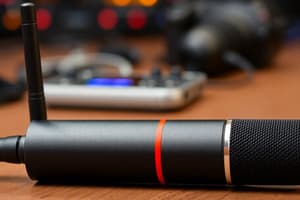Podcast
Questions and Answers
What is the primary advantage of handheld wireless microphone systems?
What is the primary advantage of handheld wireless microphone systems?
- Unobtrusive and aesthetically pleasing
- Improved noise cancellation
- Longer range compared to other types
- Easy setup and operation (correct)
Which type of wireless microphone system is ideal for fitness instructors?
Which type of wireless microphone system is ideal for fitness instructors?
- Handheld Systems
- Lavalier Systems
- Headset Systems (correct)
- None of the above
What is a disadvantage of lavalier systems?
What is a disadvantage of lavalier systems?
- Heavy and cumbersome
- Sensitive to clothing rustling and other movements (correct)
- Limited range
- Requires extensive setup
What is a benefit of using wireless microphone systems?
What is a benefit of using wireless microphone systems?
What is a limitation of handheld wireless microphone systems?
What is a limitation of handheld wireless microphone systems?
What is an advantage of headset wireless microphone systems?
What is an advantage of headset wireless microphone systems?
In which type of events are lavalier systems commonly used?
In which type of events are lavalier systems commonly used?
What is a disadvantage of handheld wireless microphone systems?
What is a disadvantage of handheld wireless microphone systems?
What is a disadvantage of lavalier systems?
What is a disadvantage of lavalier systems?
What is an advantage of instrument systems?
What is an advantage of instrument systems?
What is a disadvantage of camera mount systems?
What is a disadvantage of camera mount systems?
What is a benefit of wireless microphone systems?
What is a benefit of wireless microphone systems?
What is frequency coordination in wireless microphone systems?
What is frequency coordination in wireless microphone systems?
What is a potential problem that can occur when multiple wireless systems operate on the same frequency?
What is a potential problem that can occur when multiple wireless systems operate on the same frequency?
What is intermodulation distortion?
What is intermodulation distortion?
Why is it important to understand frequency coordination in wireless microphone systems?
Why is it important to understand frequency coordination in wireless microphone systems?
What is a frequency coordination tool used for?
What is a frequency coordination tool used for?
What is the purpose of creating a frequency coordination chart or spreadsheet?
What is the purpose of creating a frequency coordination chart or spreadsheet?
What is the main consideration when allocating frequencies for wireless microphone systems?
What is the main consideration when allocating frequencies for wireless microphone systems?
What is the purpose of proper antenna placement and orientation?
What is the purpose of proper antenna placement and orientation?
What is the purpose of frequency agile systems?
What is the purpose of frequency agile systems?
What is the purpose of monitoring and troubleshooting in wireless microphone systems?
What is the purpose of monitoring and troubleshooting in wireless microphone systems?
Why is it essential to regularly monitor the frequency spectrum?
Why is it essential to regularly monitor the frequency spectrum?
What is the first step in setting up a wireless microphone system?
What is the first step in setting up a wireless microphone system?
What is the purpose of a site survey?
What is the purpose of a site survey?
Why is it recommended to position antennas vertically and away from metal objects?
Why is it recommended to position antennas vertically and away from metal objects?
What is the purpose of frequency coordination?
What is the purpose of frequency coordination?
What is the purpose of leaving space between channels?
What is the purpose of leaving space between channels?
What is the primary cause of interference in wireless microphone systems?
What is the primary cause of interference in wireless microphone systems?
How can you identify a cleaner frequency option for your wireless microphone system?
How can you identify a cleaner frequency option for your wireless microphone system?
What is the benefit of using rechargeable batteries in wireless microphone systems?
What is the benefit of using rechargeable batteries in wireless microphone systems?
Why is regular maintenance of wireless microphone systems important?
Why is regular maintenance of wireless microphone systems important?
What should you do to ensure uninterrupted operation of wireless microphone systems during live events?
What should you do to ensure uninterrupted operation of wireless microphone systems during live events?
What should you do to clean microphones and transmitters?
What should you do to clean microphones and transmitters?
Why is it important to inspect cables and connectors regularly?
Why is it important to inspect cables and connectors regularly?
What should you do to prevent damage during transportation of wireless microphone systems?
What should you do to prevent damage during transportation of wireless microphone systems?
Flashcards are hidden until you start studying
Study Notes
Wireless Microphone Systems
- Wireless microphone systems provide freedom of movement and eliminate the need for cumbersome cables.
Types of Wireless Microphone Systems
- Handheld Systems:
- Consist of a wireless handheld microphone with a built-in transmitter and microphone capsule
- Advantages: easy setup and operation, mobility, and portability
- Disadvantages: limited range, may cause fatigue during extensive use, and limited options for microphone capsule selection
- Lavalier Systems:
- Consist of a small clip-on microphone and a separate transmitter worn by the speaker
- Advantages: hands-free operation, unobtrusive, and aesthetically pleasing
- Disadvantages: requires proper placement for optimal audio quality, sensitive to clothing rustling, and battery-powered transmitter needs to be firmly secured
- Headset Systems:
- Consist of a small microphone attached to a headset worn by the user
- Advantages: provides freedom of movement, improved noise cancellation, and microphone stays in the same relative position as the user moves
- Disadvantages: cables can be cumbersome, requires proper adjustment for comfort and mic placement, and limited options for microphone capsule selection
- Instrument Systems:
- Designed specifically for amplifying musical instruments
- Advantages: eliminates the need for cables, reduces risk of tripping or tangling cables on stage, and enhances instrument sound quality
- Disadvantages: limitations on instrument types, interference from other nearby wireless devices or radio signals, and potential for signal dropout
- Camera Mount Systems:
- Commonly used in videography and film production
- Advantages: easy integration with cameras and camcorders, simplified audio and video syncing, and wide range of microphone capsule options
- Disadvantages: limited mobility due to connection with camera, need for additional accessories for audio monitoring, and interference from other wireless devices
Frequency Coordination and Interference
- Understanding frequency coordination involves proper selection and allocation of frequencies to avoid interference and ensure seamless performance
- Interference occurs when multiple wireless systems operate on the same frequency or are affected by external sources
- Crucial aspects to consider when working with wireless microphone systems:
- Frequency bands and regulations
- Available frequency spectrum
- Intermodulation distortion
- Frequency coordination tools
- Frequency coordination process
- Antenna placement and orientation
- Interference avoidance techniques
- Monitoring and troubleshooting
Setting Up a Wireless Microphone System
- Choosing the right equipment: consider frequency range, number of channels, receiver features, and microphone types
- Site survey: evaluate the venue's wireless environment and identify potential interference sources
- Antenna placement: position antennas vertically, away from metal objects, and at least one wavelength apart
- Frequency coordination: use professional software or online tools to choose frequencies free from interference sources
- Interference mitigation: troubleshoot and resolve interference issues during setup and performance
- Battery management: ensure fresh batteries, consider rechargeable batteries, and assess battery levels regularly
- General maintenance: clean microphones and transmitters, inspect cables and connectors, update firmware and software, and store and transport the system properly
Studying That Suits You
Use AI to generate personalized quizzes and flashcards to suit your learning preferences.




